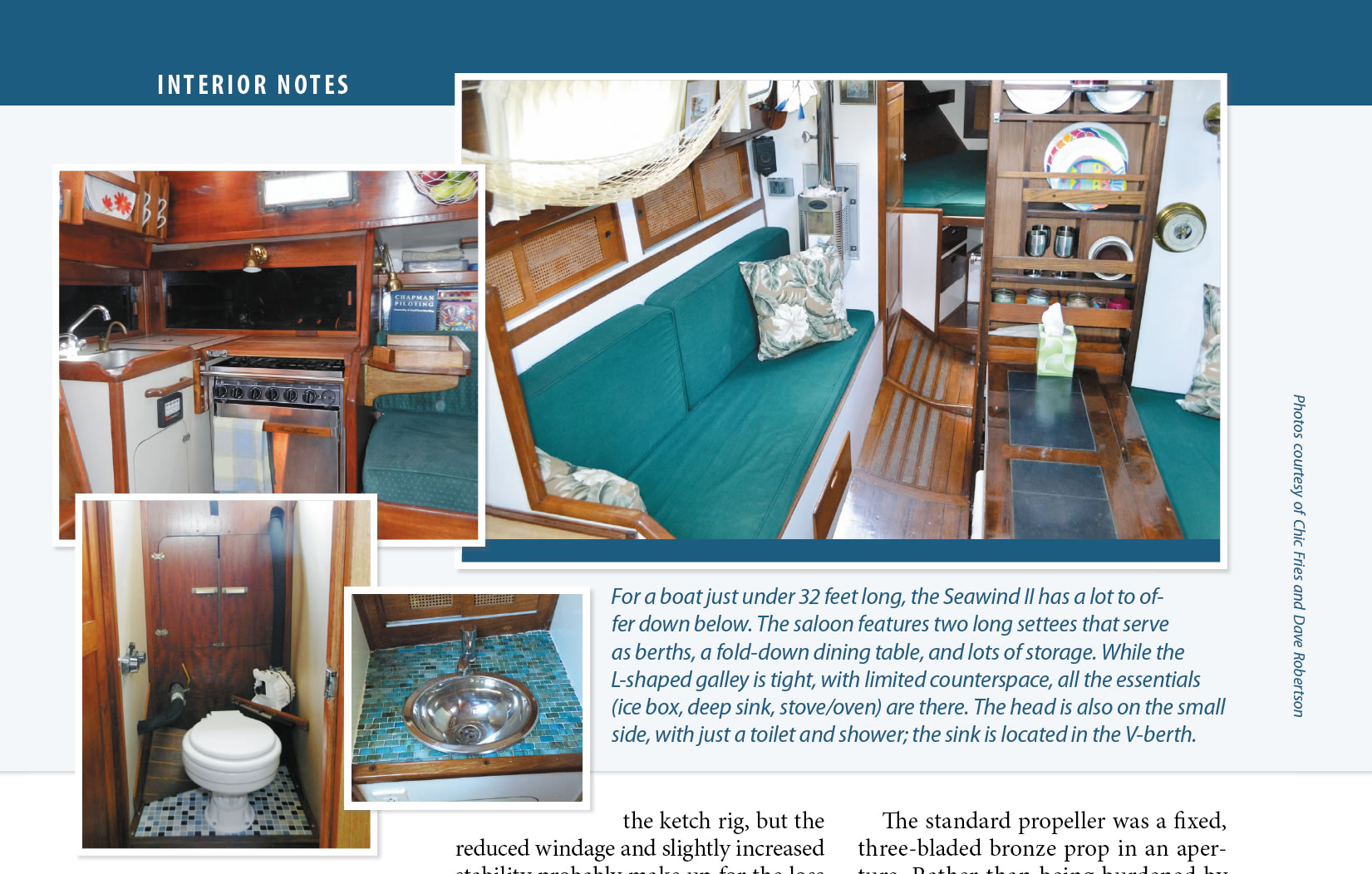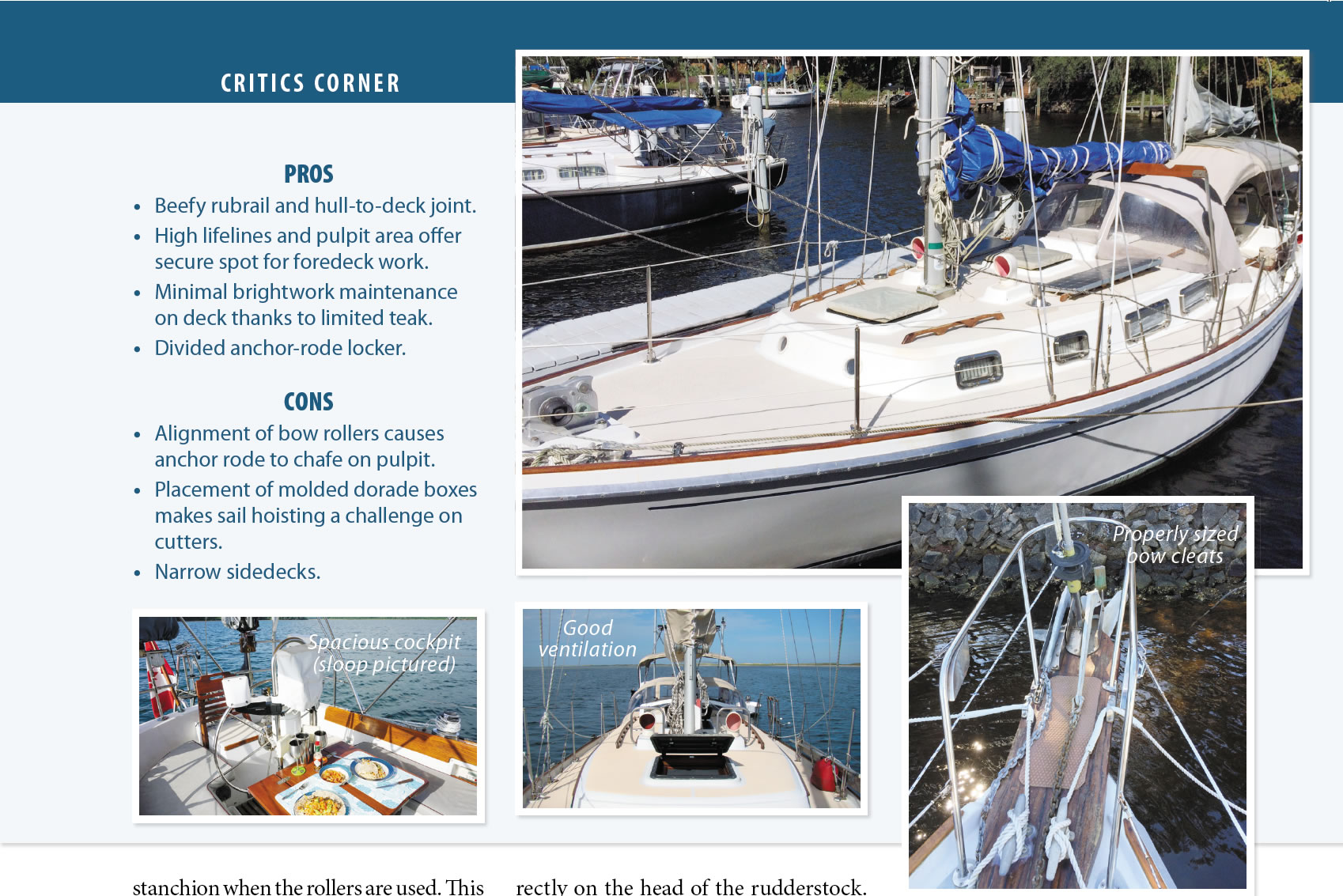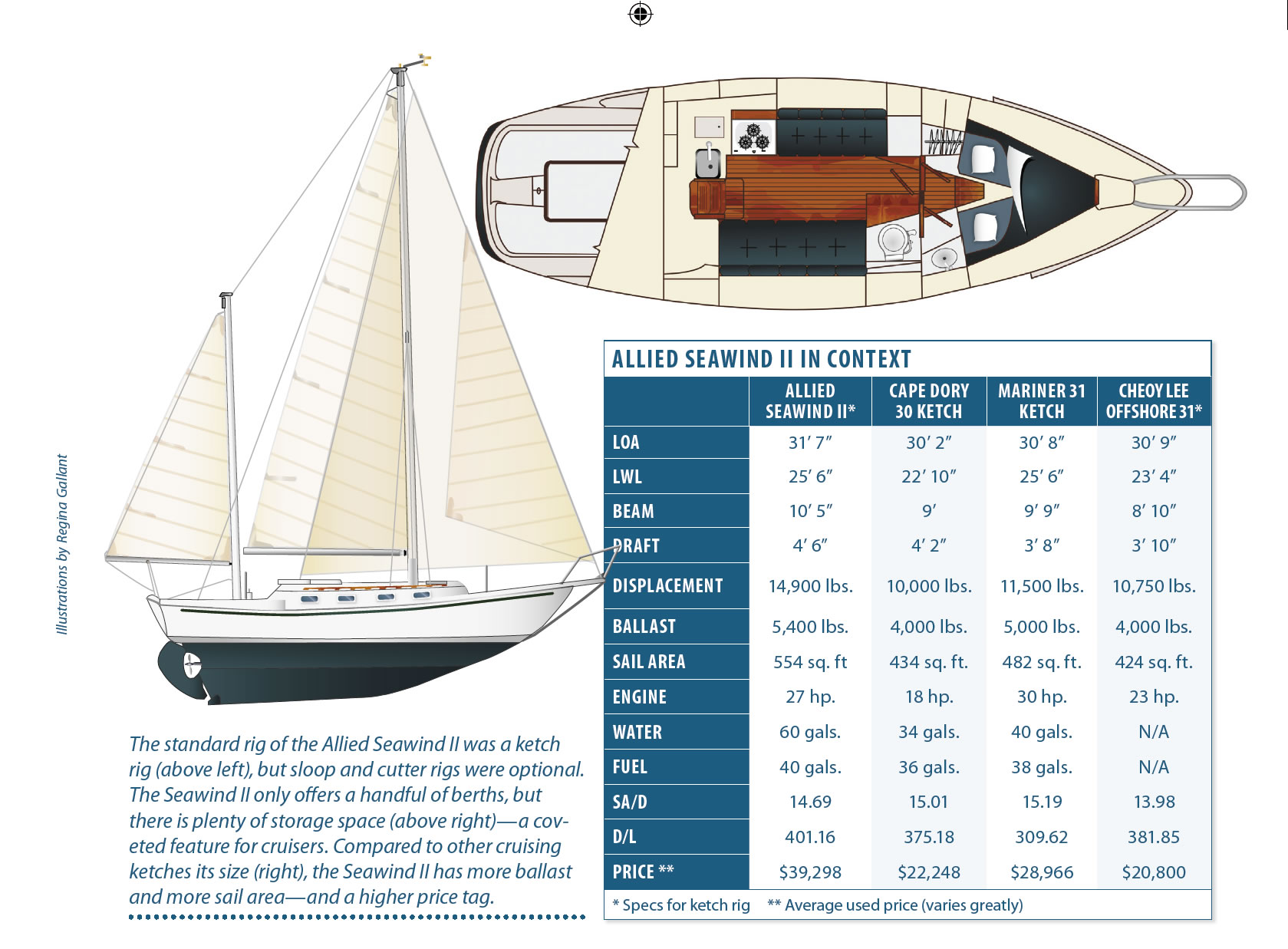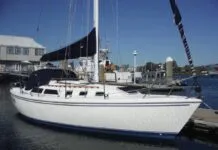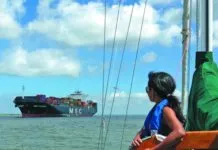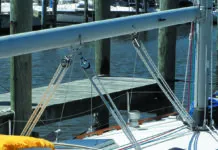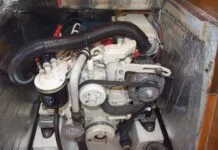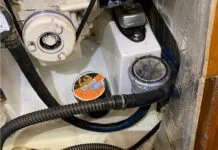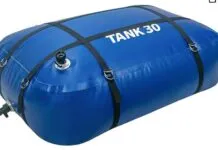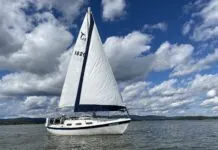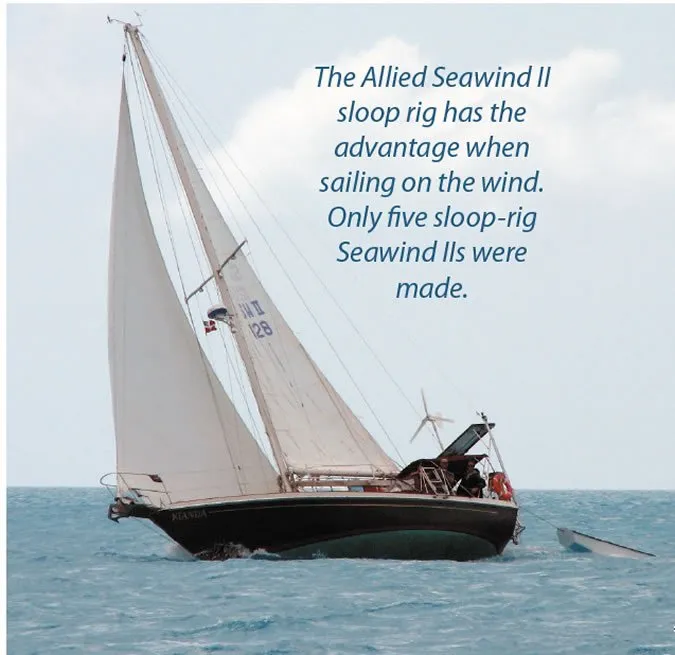Allied Yachts secured its place in the boatbuilding pantheon with its original Seawind ketch, which was launched in 1962 and was the first fiberglass boat to circumnavigate, and the Luders 33, which was recognized as a classic design of the era preceding the fin-keel racer-cruiser. Unfortunately, while its products were heading for glory on the high seas, the company was headed for the boneyard, thanks to mediocre management, severe under-exposure, and the vagaries of the boat-buying public. But by the time Allied went out of business for the fifth and final time in 1981, they had developed a reputation for fashioning solidly built (if uninspiringly finished) boats, unabashedly oriented toward cruising.
In the last years of production, Allied attempted to overcome its dowdy image. While older Allied boats were heavy on woodgrain Formica, bland expanses of fiberglass, and mediocre woodwork, later models used large expanses of interior wood and quality hardware.
Photos courtesy of Howard Hering and Dave Robertson
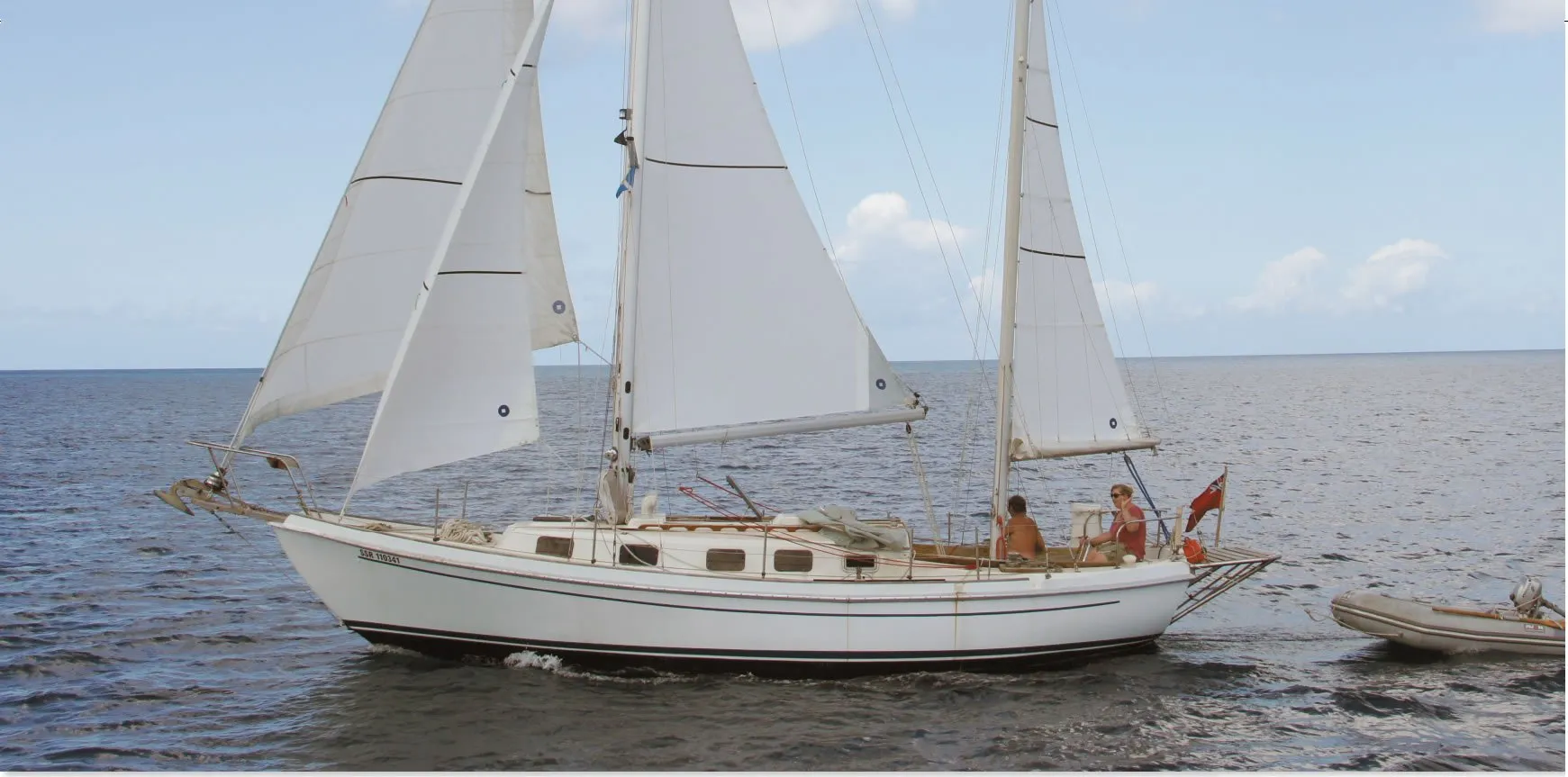
The Seawind II
In 1975, Allied began building the foot-longer, foot-wider, Thomas Gillmer-designed Seawind MkII as a replacement for the original 30-foot, 6-inch Seawind. The extra foot of length and beam, 1 feet of waterline length, and 2,700 pounds of displacement added up to make the Seawind II a significantly larger boat than its predecessor-and it was also significantly more expensive. Handmade by American craftsmen on the shores of New Yorks Hudson River, both Seawind designs were produced until Allied closed its doors at the end of 1981. Allied produced 130 Seawind II boats. Of those, most were the standard ketch rig, but 11 were cutter rigs and five were sloop rigged.

Perfomance
The standard rig of the Seawind II is a masthead ketch. The mizzen and associated rigging add considerable weight and windage, without adding any upwind drive. The real purpose of a mizzen upwind is to balance the boat, and for this purpose, the smaller, more out-of-the-way mizzen of a yawl is equally useful.
Off the wind, the area of the mizzen, plus the added bonus of a mizzen staysail, do provide considerable drive. However, in a boat of this size, the mizzen mast clutters up the cockpit a bit, and its position, five feet forward of the helmsman, is guaranteed to make him cross-eyed, if he sits directly behind the wheel.
The sail area of the Seawind II is small enough that the oft-cited advantage of the ketch rig (smaller individual sails) seems rather unimportant. A mizzen is useful for heaving to, for anchoring and weighing anchor, and to enable the boat to weather-cock in a rolly anchorage. It is, however, an inefficient upwind rig, and pointing a few more degrees off the wind is typical. While that may equal a significant time cost when racing, it is compensated by better off-the-wind performance and more sail plan options (flying a staysail from the mizzen and a spinnaker downwind, for example) to cover a range of wind speeds and conditions-both of which are serious cruising advantages. According to some owners we interviewed, the Seawind IIs correctly sized mizzen makes for a very balanced sailplan; they claimed that when carrying modern full-battened sails, the ketch rig can keep up with any similar-sized sloop or cutter rig on any point of sail, but that it truly shines off the wind.
The Seawind IIs optional cutter and sloop rigs used the same mainmast as the ketch rig, but shifted it aft about a foot. On the cutter, the mainsail is longer on the foot, and the base of the foretriangle is a little longer than that of the ketch rig. The total sail area of the cutter rig works out to slightly less than that of the ketch rig, but the reduced windage and slightly increased stability probably make up for the loss of sail area. For tradewind passages, the double headstays on either rig allow for the use of twin downwind jibs. With a working sail area of over 500 square feet for a displacement of 14,900 pounds, the Seawind II is not under-canvassed, as are many cruising boats.
The Seawind IIs rudder is a large, heavy, barn-door style. The rudder, coupled with the weight of the boat, makes it hard for a wheel autopilot to do its job offshore. Changing it to a more modern Constellation-style rudder would slightly reduce wetted surface and perhaps give a little better performance with no loss of control.
The Seawind IIs standard propulsion was a lightweight, four-cylinder Westerbeke 27-horsepower diesel. This offered plenty of power for the Seawind IIs displacement, and many boats still have the original engine. Do not expect the Seawind II to maneuver like a modern fin-keeler under power. Despite her cutaway forefoot, there is enough lateral plane to require a little planning ahead in a tight situation under power. A welded aluminum fuel tank is located in the bilge; some owners have complained that it lacks an inspection port.
The standard propeller was a fixed, three-bladed bronze prop in an aperture. Rather than being burdened by the considerable drag of such a propeller, we would install a two-bladed prop that could be lined up behind the deadwood to reduce drag under sail. Alternatively, a two- or three-bladed feathering propeller could be installed. On a boat with the substantial wetted surface of the Seawind II, reducing drag becomes critical to performance in light air.
On Deck
An unusual feature of the Seawind II is its lifeline stanchions and pulpits. They stand 30 inches off the deck, rather than the more common 24 inches. Coupled with a fairly high toerail, these give a real feeling of security to anyone working the foredeck. Unfortunately, they also require that a long tack pendant be installed if you want to get the foot of the jib above the lifelines. The cutter rig has an advantage here: A high-cut yankee jib will easily clear the lifelines.
The bowsprit is a massive teak platform with an attached pulpit that is a comfortable and secure place to handle sails or groundtackle. Double bow rollers are located at the end of the sprit, but they are so far outboard that the anchor rode tends to chafe against the pulpit stanchion when the rollers are used. This prevents storing anchors securely in the roller as well. Some owners have had the bowsprit and rails redesigned for clear runs from the rollers.
The Seawind II is one of a few boats weve seen with properly sized bow cleats. There are two 12-inch foredeck cleats, with hawsepipes to the divided anchor-rode locker outside each cleat. An anchor windlass was optional and fit nicely between the cleats.
Because of the width of the cabin trunk, it is easier to get to the foredeck by walking over the cabintop than by squeezing inside the shrouds. On the cutter, the two, molded-in dorade boxes are located abreast of the mast, which means crew must straddle them awkwardly when hoisting the sails. This is less of a problem with the ketch rig as its mast is stepped farther forward.
A variety of mainsheet leads have been used on the Seawind II. The best of these consists of a traveler mounted on the bridgedeck, which reduces seating but gives much better sail control.
The standard steering on the boat was an Edson rack-and-pinion mounted directly on the head of the rudderstock. This is the only steering placement possible with the ketch rig, but other options are possible with cutter or sloop rigs; we know of some Seawind II sloops with Edson pedestal pull-pull cable steering connected to a solid bronze quadrant.
The large cockpit is somewhat crowded by the mizzen mast on the ketch, but it is reasonably comfortable and the mizzen serves as a handy foot brace. Without the mizzen, the cockpit is very spacious and offers several options for on-deck sleeping, even underway.
Large, underseat lockers on either side of the cockpit hold lots of gear, and are equipped with drop-in dividers to keep items from the depths of the very deep bilge. There is also a freshwater cockpit shower, whose spray head and hose are recessed into the side of the footwell.
The companionway is narrow, with almost parallel sides. While this may make it a little less convenient to get below, it is far more seaman-like than most companionways. Coupled with a molded-in seahood and a good bridgedeck, it provides well-designed access for people but not water.
Belowdecks
On latter-day Seawind IIs, we were pleased to find the best finished interiors of any Allied boats wed seen. The layout is conventional, and as befits a serious cruising boat, there is tremendous storage throughout. Allied offered a number of customizable storage options, such as a bureau, extra drawers, and extra cabinets that allowed new owners to tailor the boat to their individual needs.
The forward cabin features a V-berth, a hanging locker, and a wash basin. Under the berth, there are drawers, bins, and a large, stainless-steel holding tank. A door from the forward cabin offers access to the head without entering the main saloon. The primary door between the main saloon and the forward cabin also shuts the head off from the main saloon.
The small head contains only the toilet and a shower. Its doors are extremely narrow, since their heavy framing also carries the compression load of the rig.
Because the settees in the main cabin are asymmetrical, it is not possible to accommodate more than four people at the fold-down dining table. But given the number of berths onboard, this should rarely be a problem. The space behind the settees is given over to storage, rather than attempting to cram more berths into the boat.
A number of galley stove options can be found on Seawind IIs, including surface-mounted kerosene and alcohol stoves, and gimballed LPG, kerosene, or alcohol stoves with ovens. The L-shaped galley has limited counterspace, so some owners have installed hinged, foldaway extensions.
The icebox was insulated with four inches of urethane foam, and has a tight fitting, well-gasketed top. While this was a highly efficient design, owners of older Seawind IIs have found it necessary to re-insulate the icebox or have opted to replace it with a fridge.
The large, deep sink is equipped with both pressure freshwater taps and a manual pump-an essential feature for cruisers looking to save amps.
Although there is no navigation station-not shocking on a boat of this size-there is a large dresser surface on the starboard side aft of the settee that can be used as a nav table.
Testers rated engine access as fair. The engine is tucked away under the cockpit, and it is necessary to remove both the companionway ladder and the bulkhead panel behind, in order to check the oil. This is not conducive to good engine maintenance. However, the opening is wide, and there is an oil pan under the engine, so spilled oil will not drain into the bilge sump. Neither the shower nor the icebox drain into the deep bilge either, a welcome feature.
With its wide cabin trunk, good headroom, and no attempt to sleep an army in tiny, uncomfortable berths, the Seawind II provides excellent accommodation for a couple or family with small kids, either living aboard or for extended cruising. That is what the Seawind II is all about.
Conclusions
Like its cousin, the Southern Cross 31, the Seawind II is a cruising sailors dream machine. Its construction is strong without being inordinately heavy. With twin running headsails, and sails built for speed as well as durability, the Seawind II should have good performance for a pure cruising boat.
While those who prioritize upwind performance would be well served with the cutter- or sloop- rig Seawind II, there are only a handful of them in existence, and even fewer up for sale.
However, a quick online search shows several Seawind II ketches for sale, priced from $28,000 to $60,000. The ketch rig would make a great liveaboard or extended cruising boat for couples and young families, especially those planning to sail the tradewinds or other downwind-dominant areas. Unless youre planning to race or have parties in your cockpit, the addition of a mizzen and its rigging are outweighed by superior off-wind performance, easier-to-handle sails, and more sail-combo options to optimize performance in a wide range of conditions.
Owner comments
Not counting the spinnaker common to all four rigging options, the greatest of [the ketchs] advantages is the natural division from two sails into three sails, or even five, when adding a staysail forward (as in the cutter, but with a flying forestay that is kept alongside the main mast side stays when not in use), and another of lighter material between the two masts. This enables cruisers to sail long stretches without modifying the sail arrangement when the wind varies around a given strength.- Bertrand de Frondeville, former owner of Pianissimo, Seawind II ketch, Rye, N.Y.
The solid lead keel saved our bacon a few times running aground. She is very forgiving; the only damage was some gelcoat pulling away from the lead…. We always feel safe on her at sea. She may be the last one to cross the finish line, but we like that it will be comfortable getting there! – Dave Robertson and Jessica Hahling, Kianda, Seawind II Hull #128 sloop, Kingston, Ontario
The added benefit of being able to fly a staysail from the mizzen and a spinnaker downwind makes the ketch unbeatable in my opinion. My mizzen is always the first sail up and the last sail down. … [Seawind IIs] are the best kept secret for bluewater cruising boats in the 30- to 35-foot category. The boat is a dream to sail. – Chic and Patti Fries, Estrellita, 1976 Seawind II Hull #37 ketch, Destin, Fla.
